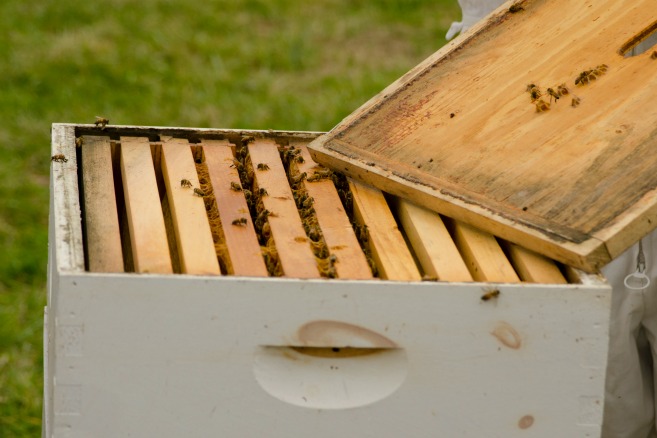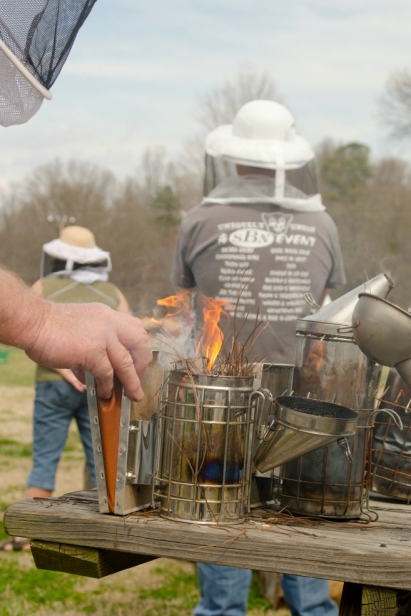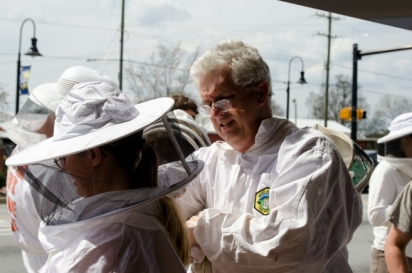An Inevitable Beekeeper
Before I was an urban farmer, I played with bugs. Any Upstate critter with six legs and an exoskeleton had equal opportunity to spend time behind glass on my bedroom shelf. I brought home entire nests of wriggling tent caterpillars, ant mounds, singing crickets, screaming cicadas, sparkling fireflies, and even a golf-ball sized Hercules beetle my mom later found clinging to a laundry basket. The first Peterson’s insect guide I owned eventually disintegrated and I still don’t know if it was due to how many times I’d looked up what to feed a new entomological find or the mistake of trying to raise actual bookworms.
One of my earliest memories involved a luminous green moth found under a street lamp and the fragile clutch of eggs she laid. Daily offerings of persimmon tree boughs were gathered on my dad’s commute home from work in order to feed hundreds of greedy green larva. While on a beach vacation, we discovered they don’t stay cocoons for long. Our arrival home was welcomed by dozens of luna moths clinging to the sheer curtains like stained glass. Since their defense mechanism is to defecate when disturbed, my mom didn’t find it as magical as I did.
Most people grow out of this kind of thing. For me, adulthood meant I finally had a house to myself without a mother to traumatize. I was free to raise water beetles in my hall aquarium and store torpid beneficial insects in the refrigerator. Out in the garden I stuffed my beds with larval host plants, nectar sources and insect habitat. At one point my screened porch was full of potted sweet gums, hickories, oaks, maples, tulip trees and persimmons, along with eight different species of giant North American silkmoths. I even tried my hand at raising commercial silk— the caterpillars of Bombyx mori are so completely domesticated and helpless that they will starve to death unless you place their mulberry leaves directly on top of their head.
I thought I was content ruling my bug kingdom until my friend Kirsten showed me her new beehive. Higher crop pollination and fresh honeycomb sounded appealing, but mostly I just wanted to geek out observing honeybee behavior. The insect lust was unbearable. Next thing Kirsten knew, we were decked out in bee suits (in the middle of the night, no less), duct taping the fully functional hive I’d impulsively bought and loading it into the back of my pickup truck. Presto! I was a beekeeper.
I would like to tell you that all my experience with arthropods paid off and I was an instant success. Not really. The most I can claim for the past six years is that I still have bees, though I’ve only harvested honey once. Late last season I lost two out of my three hives and felt humbled to the verge of quitting. Then I learned about a two-day beekeeping class offered through the Clemson Cooperative Extension Service and The Carolina Honey Bee Company.
In November of 2012, Tim Dover and Susan Gardner partnered to open their charming beekeeping store in downtown Travelers Rest. It started a few years back when Susan spontaneously bought an entire semi-truck trailer full of bee packages to sell on a word-of-mouth basis— my kind of woman. Tim panicked, until they sold out in a matter of weeks. The following year, they doubled the order, sold out again, and began offering small batches of beekeeping equipment at their back doors. When South Carolina introduced a new law requiring commercial honey be packaged in an approved kitchen, it sped the decision to open the store. However, Tim tells me that the most urgent motivation involved two homes stuffed wall-to-wall with insect raising equipment and irritated spouses. Sounds familiar.
The explosion in the popularity of beekeeping didn’t go unnoticed by the Clemson Cooperative Extension Service. Partnering with local experts to provide classes for the public was a good fit for their goal of grassroots outreach. The Carolina Honey Bee Company needed a classroom, and the Extension Service needed instructors.
The Carolina Honey Bee Company assembled a full panel of the area’s top beekeeping experts to greet us on the first day of class. Each taught a different subject, including “How Bees Think,” “Beekeeping Equipment,” “Resources Bees Collect,” and “Strains of Bees.” It was helpful to realize (through how much they teased each other) that even the experts don’t always agree. Tim laughingly told us that you could ask 10 beekeepers for advice and get 12 conflicting responses. It gave me more confidence to experiment and make mistakes.
Regional Extension Agent Danny Howard sat in as one of the panel members. If you need to report a honeybee swarm in the Upstate, Danny is the person to call. He cheerfully demonstrated swarm retrieval with a hand-made contraption reminiscent of the board game Mousetrap. The idea is to place a massive aluminum funnel under the buzzing bee cluster, shake them into a screened wooden cage, and quickly shut a sliding door held fast by rubber bands and paper clip hooks. If it is a hot day, this rickety box of stings has to be kept inside Danny’s air-conditioned vehicle to prevent overheating. I feel pretty certain he raised bugs for fun as a kid.
The quantity and quality of knowledge presented throughout the day was exemplary, but my Eureka-moment was discovering I hadn’t caused my hive failures; a pile of dead bees in front of a hive is almost certainly a pesticide kill. It turns out that most chemical pest and disease controls can be fatal to honeybees. Sprays are lapped up alongside flower nectar and powders are packed in their pollen baskets to share with the hive. Since workers forage up to a five mile radius outside their hive, beekeepers are powerless to prevent hive loss.
This discouraging news didn’t scare anyone off. The following day our class slowed traffic as we eagerly donned veils and gloves outside The Carolina Honey Bee Company store. Tim had set up six of his own hives in a nearby field so we could gain informative hands-on experience. I couldn’t wait to go home and finally experience the joy of looking in my hive and knowing exactly what’s going on— that dancing bee is telling everyone where the best flowers are, and this peanut-sized queen cell means they are planning to swarm. Still, the best part for me is realizing there are so many people who want to play with bugs.







